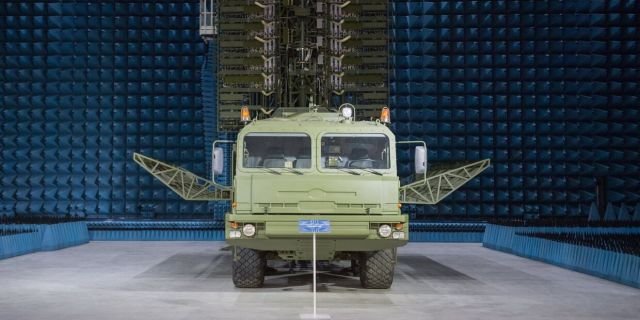How does Russia intend to destroy American F-22 and F-35 in case of war
The String-1 bistatic radar is not a death sentence for stealth aircraft, but in the course of future conflicts it may pose a serious threat to NATO aviation, writes The National Interest. The author notes that inconspicuous attack fighters are especially vulnerable to it.
Charlie Gao
Since the development of stealth technology for aviation, many systems have appeared that are advertised as "stealth killers". One of the most innovative is the Russian bistatic radar station "String-1" / "Barrier-E", developed by a division of the Almaz-Antey concern NNIIRT. Almaz-Antey is the main manufacturer of anti-aircraft and radar systems in Russia. He makes the Buk, Tor and S-400 air defense systems, as well as search radars for them. The first version of the Struna-1 radar was developed in 1999. In the future, this project was developed, which resulted in an improved Barrier-E station. The first demonstration of this development, intended for export supplies, took place at the MAKS-2007 exhibition. It is missing from the Almaz-Anteya product catalog, but it was shown at the MAKS-2017 salon. There are rumors that such radars are deployed around Moscow.
"String-1" differs from most radars in that it is a bistatic radar. This means that the transmitter and receiver in it are separated by a large distance, while in a conventional radar station they are in the same place. Conventional radars are limited by the specifics of the propagation of radio waves. As the radar target moves away from the transmission source, the radar signal strength weakens. However, the radar detection system works by receiving a reflected signal. In a conventional radar, this leads to the fact that the received signal is four times weaker than the emitted one. Stealth technologies involve the use of various materials that scatter or absorb radio waves at a distance, which is why the reflected radar signal is significantly weakened. The quality of radar tracking is deteriorating, which makes it much more difficult to get accurate information about the target.
In String-1, this problem is solved by separating the receiver and transmitter by a certain distance. Due to this, the receiver receives a more powerful reflected signal compared to a conventional radar. Thus, the radar becomes more sensitive, since now it is essentially a radar trap. This principle of operation almost triples the effective target scattering area (ESR) and allows you to ignore anti-radar coatings that can scatter radio waves. This makes it possible to detect not only stealth aircraft, but also other air objects with low ESR, such as cruise missiles and hang gliders. One radar complex can include up to ten pairs of receiver-transmitters, which in Russian publications are called receiving-transmitting posts (IFPS). There are different opinions about the configuration of such posts, but the maximum distance between two checkpoints can reach 50 kilometers. Thus, one radar theoretically covers a section up to 500 kilometers wide.
These separate radar receiving and transmitting stations consume quite little electricity and have lower radiation power compared to conventional radars. Thanks to this, they are better protected from anti-radar weapons. IFPS are mobile, which allows them to be quickly transferred to the frontline area during the conflict. They are connected to each other and to the central tracking station by ultra-high-frequency data transmission channels. The central station can be deployed at a considerable distance from the complex. Such a spaced architecture of the complex allows it to maintain its operability even in the event of the destruction of one IFR, although the detection accuracy may decrease. The low height of the receivers and transmitters (only 25 meters above the earth's surface) allows the String-1 to detect low-flying targets very effectively, which are often difficult to detect with conventional radar.
Among the disadvantages of the "String-1" is the low detection height. Due to the use of spaced posts with a transmitter and receiver, the detection zone has the shape of a parabola. As a result, the maximum detection altitude is about seven kilometers at the highest point, and the maximum range decreases as you approach the IFR. The transverse dimensions of the detection zone are also limited, amounting to about one and a half kilometers near the posts and 12 kilometers at the optimal point between the two posts. The relatively small size of the detection zone to a certain extent limits the possibilities of using the String-1 as a trap, and it cannot become a full-fledged replacement for traditional radars as a search mechanism. But having a high accuracy of tracking invisible aircraft, the String-1 perfectly interacts with other radar complexes of a wider range, such as the Sunflower radar, which has a lower tracking accuracy. "String-1" cannot act as a target designation radar, since it is not able to provide constant radar irradiation and target tracking. Therefore, it cannot be used to target semi-active surface-to-air missiles.
The String-1 bistatic radar is not a death sentence for stealth aircraft, but it may pose a serious threat to NATO aviation in future conflicts. Attack fighters with stealth characteristics are particularly vulnerable, since they differ in a specific flight profile that literally drives them into the range of the Struna-1 radar. Operating in tandem with other radar detection systems "invisible", this station can collect important information about the location and movements of stealth aircraft.
Charlie Gao studied political science and computer science at Grenell College. He often makes comments on defense and national security issues.

